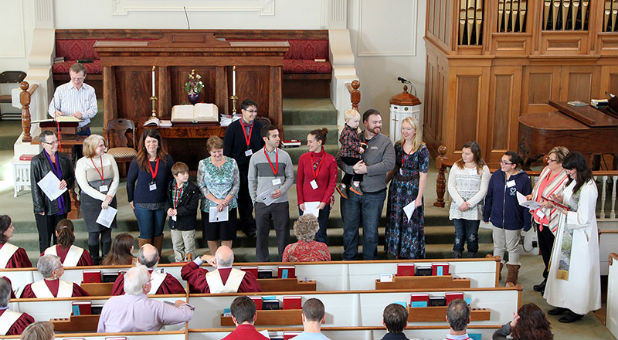Which Churches Are Growing Fastest and Why
“It comes down to being all you can be in a religious setting,” he said. “These congregations feel they are energetically living out their understanding of their call.”
Hope thrives where change is welcome, Roozen said. “Thriving congregations are nearly 10 times more likely to have changed themselves than are struggling congregations.”
“That’s critical,” said Nancy Ammerman, professor of sociology of religion at Boston University. She observes that those aging congregations slipping toward insolvency “can take a long time to die because a handful of really determined folks will keep it going. That works — if they are willing to revolutionize themselves.
“People haven’t lost the urge to congregate together spiritually. But how they do it is being expressed differently and the churches that do well are reshaping constantly,” she said.
The Rev. Jon Brown left a denominational headquarters job to lead a congregation of 45 participants at Old Bergen Church in Jersey City, N.J. Five years later, Old Bergen, a multiethinic, multiracial congregation, averages 100 people in the pews on Sundays — and tries new things constantly.
To him, this congregation is “a treasure hidden in a field,” he said, echoing a parable in the Gospel of Matthew.
In Roozen’s study, the percentage of congregations that reported more than 2 percent growth in worship attendance was at 45 percent, down from 57 percent in 2005.
Congregations that beat the 2 percent growth rate were:
- located in new suburbs (59 percent)
- offered “very innovative worship” (53 percent)
- served fewer than a third seniors (47 percent)
Bethany Lutheran Church, an evangelical congregation in Bigfork, Mont., has none of those advantages.
It’s even smaller than it was when the Rev. Christopher Miller arrived nearly five years ago — down to 92 people at Sunday worship. A contentious split with the more liberal Evangelical Lutheran Church in America prompted young families to leave — and leave behind the debt incurred when the congregation expanded the sanctuary and built new facilities for the youth.
Still, Miller looks up: “I don’t know what Bethany will look like on quantitative terms but by qualitative ones, God is showing himself faithful.”
His motto is from the Little Mermaid’s song in the Disney film: “I want to be where the people are … ”
That means building relationships, weaving young people into the life of the church, and the church into the community and beyond. The Bethany congregation has built six churches in Honduras with funds raised washing cars and selling huckleberry pies. Next up, installing a free library stand in downtown Bigfork where people who pause to browse can drop a prayer request in a mail slot below the books. The idea, said Miller, is to “show people what is important to them is important to us.”
Attracting young adults and families is a challenge in any location at a time when restless “church shoppers” move amid competing congregations, said Roozen.
While more than 20 percent of the U.S. population is 18–34 years old, that age group represented only 10 percent of U.S. congregations in 2015, down from 15 percent in 2010, the congregations study finds. More alarming, Roozen said, is that fewer churches were making this age group a priority.
The latest Pew Research Landscape studyto examine American’s beliefs and practices, released in November, found slow but steady decline from 2007 in the percentages of U.S. adults who say they believe in God, pray daily and regularly go to church or other religious services all have declined modestly in recent years. The chief reason: The rise of people, particularly Millennials, who identify with no religion.
Doug Davis, who grew up attending First Church in Sterling and at age 50 is the youngest deacon, said church elders looked around and saw few young adults in the pews. Davis said, “We realized we were falling behind in energy and that was no way to be vibrant.”
While more than 20 percent of the U.S. population is 18–34 years old, that age group represented only 10 percent of U.S. congregations in 2015, down from 15 percent in 2010, the congregations study finds. More alarming, Roozen said, is that fewer churches were making this age group a priority.
The latest Pew Research Landscape studyto examine American’s beliefs and practices, released in November, found slow but steady decline from 2007 in the percentages of U.S. adults who say they believe in God, pray daily and regularly go to church or other religious services all have declined modestly in recent years. The chief reason: The rise of people, particularly Millennials, who identify with no religion.
Doug Davis, who grew up attending First Church in Sterling and at age 50 is the youngest deacon, said church elders looked around and saw few young adults in the pews. Davis said, “We realized we were falling behind in energy and that was no way to be vibrant.” {eoa}
© 2016 Religion News Service. All rights reserved.














































